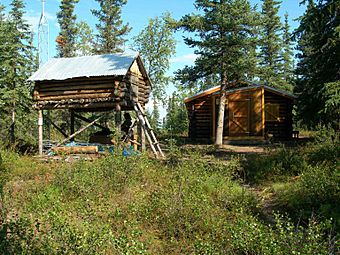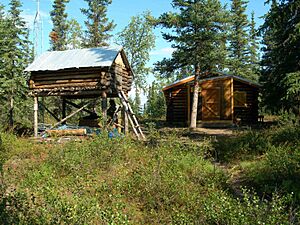Onion Portage Archeological District facts for kids
|
Onion Portage Archeological District
|
|

The Giddings cabin
|
|
| Location | Address restricted |
|---|---|
| Nearest city | Kiana, Alaska |
| NRHP reference No. | 72000191 |
Quick facts for kids Significant dates |
|
| Added to NRHP | June 20, 1972 |
| Designated NHLD | June 2, 1978 |
The Onion Portage Archeological District is a very important archaeological site in Kobuk Valley National Park in northwestern Alaska. It's like a giant history book buried in the ground!
Archaeologists have found nine different layers of human activity here. These layers show how people lived from about 6500 BC all the way to 1700 AD. This site has been super helpful for learning about the history of people in the Arctic. It helps scientists figure out the timeline of different cultures in the region.
This special area was added to the National Register of Historic Places in 1972. It was then named a National Historic Landmark in 1978. This means it's one of the most important historical places in the United States.
Contents
Where is Onion Portage?
The Onion Portage site sits on the northern bank of the Kobuk River. Above the site, there is a sandy hill. Rain and wind wash sand and other materials from this hill onto the site. This process helped bury and preserve the ancient layers over thousands of years.
Discovering Ancient History
The Onion Portage site was first found by a famous Arctic archaeologist named J. Louis Giddings. He discovered it in 1940 during his first trip to the Kobuk River.
Early Excavations
Giddings came back to the site in 1941. He dug up some old house pits, but he didn't fully know how important the site was yet. After World War II, Giddings worked on other sites. These included the Iyatayet Site and places at Cape Krusenstern National Monument. He started to put together a timeline of Arctic cultures from these discoveries.
Uncovering Deep Layers
In 1961, Giddings visited Onion Portage again. This time, he found out that the site had many, many layers of history buried deep down. Each layer was like a different chapter in time.
In 1964, Giddings led a big excavation at the site. This was the last year of his life. He was looking for signs of even older cultures in the many layers of dirt and artifacts. His work at Onion Portage helped us understand thousands of years of human life in the Arctic.
The Giddings Cabin
The only building at the Onion Portage Archeological District is the Giddings Cabin. J. Louis Giddings used this cabin during his 1964 dig. The National Park Service has kept the cabin safe and preserved it.


